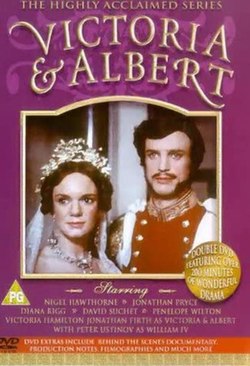| Victoria & Albert | |
|---|---|
 | |
| Genre | Period drama |
| Directed by | John Erman |
| Starring | Victoria Hamilton Jonathan Firth Peter Ustinov Jonathan Pryce |
| Composer | Alan Parker |
| Country of origin | United Kingdom United States |
| Original language | English |
| No. of series | 1 |
| No. of episodes | 2 |
| Production | |
| Executive producers | Sue Deeks Delia Fine Doug Schwalbe |
| Producer | David Cunliffe |
| Running time | 200 minutes |
| Production companies | Own2feet Productions Splendid Television for BBC |
| Original release | |
| Network | BBC One (UK) A&E (U.S.) |
| Release | 26 August – 27 August 2001 |
Victoria & Albert was a 2001 British-American historical television serial. It focused on the early life and marriage of Queen Victoria and Prince Albert. The series starred Victoria Hamilton as Victoria, Jonathan Firth as Prince Albert and Peter Ustinov as King William IV. It was directed by John Erman. [1]
Contents
In the UK it was broadcast by the BBC, split into two parts of 100 minutes each. The series is now available on DVD.